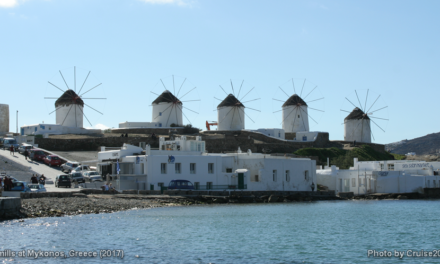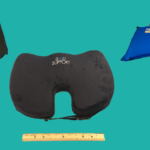A cruise is like any other vacation. You get more out of it when you plan and prepare properly. Many folks which whom I speak think a cruise vacation is simply “book, pay, and go” and that everything is handled for you. While you can book a cruise this way, you will get more out of a cruise by planning your experience.
I am often asked how I go about planning a cruise. In the beginning, I must say I made many mistakes, and I probably still still make mistakes. However, I have gotten better at finding deals in making each cruise somewhat special. After analyzing my process, I came up with the six steps that. I will add additional posts to expand these steps and provide some specific pointers.
Step One: Estimating the Cost of the Cruise
 I am assuming that most of us are not traveling on unlimited budget. It is important that you establish how much you’re willing to spend before embarking on planning your cruise. Your budget will influence many decisions along the way. Keep in mind that your budget should include not only the cost of the cruise, but transportation getting to and from the cruise, shore excursions, and extra costs on board such as gratuities, drinks, and special meals. Your budget will depend on where you plan to travel and how long you plan to travel. When you develop your budget, keep in mind that you will have time to save up for the final payment. We plan some of our trips over a year in advance, so this gives us time to plan our expenses. Some general rule of thumb by which I plan are:
I am assuming that most of us are not traveling on unlimited budget. It is important that you establish how much you’re willing to spend before embarking on planning your cruise. Your budget will influence many decisions along the way. Keep in mind that your budget should include not only the cost of the cruise, but transportation getting to and from the cruise, shore excursions, and extra costs on board such as gratuities, drinks, and special meals. Your budget will depend on where you plan to travel and how long you plan to travel. When you develop your budget, keep in mind that you will have time to save up for the final payment. We plan some of our trips over a year in advance, so this gives us time to plan our expenses. Some general rule of thumb by which I plan are:
1.1 Estimate Cruise Rate
I budget $150-200 per person per day for balcony room and suggest around $75-100 for an inside or oceanview room. Yes, you will find rates that are higher or lower than this, but, for budgeting purposes, this works perfectly well.
1.2 Estimate Cost for Excursions and Port Expenses
As a rule of thumb, I budget $100 per person per port for excursions and miscellaneous costs. If you prefer more adventurous or exotic excursions, you might want to use a larger number. As you cruise more, you will gain a sense of what excursions costs and how much you will spend in ports for meals and other expenses.
1.3 Estimate Gratuities and Onboard Expenses
From experience, I budget $30 per person per day for gratuities and onboard expenses. We are not heavy drinkers, nor do we pay for a lot of extraneous activities on board. If you prefer to drink, play bingo, gamble, or use specially dining, you should estimate more.
1.4 Estimate Costs to Get to and from the Ship
There are several factors to consider here. I have been on trips where the costs getting to and from the port are almost as much as the cost of the cruise. Some of the key components of this cost are:
If driving, cost of parking. If you are close enough to drive, don’t forget the costs to park your car. On an upcoming trip, we are driving to the port, which means we will be paying around $25 per day for parking.
Air Fare. I estimate domestic airfare at $400 per person international airfare at $1500 per person for economy class. If you want to travel in more luxury, increase this estimate accordingly.
Pre-cruise Hotel and Meals. Consider arriving a day early to avoid problems with air travel (I will discuss this in a separate post). Allow for a one-day hotel stay and meals for this day. If you stay at a hotel that does not provide shuttles to the air, add in some extra for shuttles. I have found this to be around $200-250 for hotel and meals for two persons.
1.5 Contingency for Miscellaneous Items.
Add some contingency for other factors, such as gifts and souvenirs, normally around $300. Since mist establishments now take credit cards, I usually come back with most of this money, but I like to have some cash just in case.
1.6 Travel Insurance
Although travel insurance is optional, I do highly recommend it. Remember that cruise lines will not refund your fare if you have an emergency or miss the ship. Should something happen after you have made the final payment, you can kiss that money good-bye, even though the cruise line will then sell your cabin to someone else. Travel Insurance costs 5-10% of the insured amount, depending on the level of insurance you require. I make sure that my wife and I are insured for the cruise and any pre- and post-cruise stays using a policy that covers pre-existing conditions. Read my post on insuring your airfare, as there are alternatives for protecting your airfare. I have only filed one claim in over 30 cruises due to a medical emergency, but I received full compensation in less than two weeks. I have had several other situations including a medical emergency and weather delay that might have resulted in claims, but they were all handled with no impact. I will not travel unless I am insured.
Example
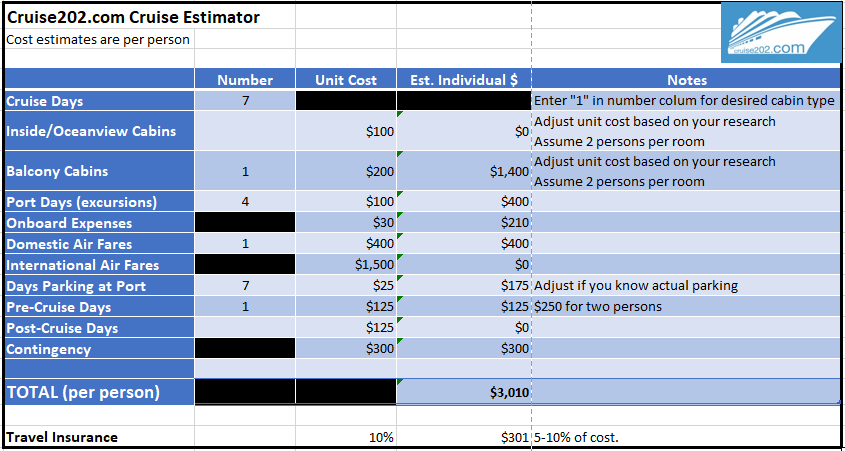 Using this formula, a seven day Caribbean cruise with four ports will be budgeted at $3,010 per person plus the cost of the travel insurance. I suspect this will be a high number, but it will give you a good idea what the trip could cost. As you continue your research, you will find deals and methods to reduce costs. This could be something as simple as finding a cruise during a low period that is offering great fares (e.g., Baja Mexico during the first two weeks of December) or promotions for paid gratuities and onboard credits. We have even managed to find free or reduced airfares and free pre-cruise hotel deals.
Using this formula, a seven day Caribbean cruise with four ports will be budgeted at $3,010 per person plus the cost of the travel insurance. I suspect this will be a high number, but it will give you a good idea what the trip could cost. As you continue your research, you will find deals and methods to reduce costs. This could be something as simple as finding a cruise during a low period that is offering great fares (e.g., Baja Mexico during the first two weeks of December) or promotions for paid gratuities and onboard credits. We have even managed to find free or reduced airfares and free pre-cruise hotel deals.
I have created a simple spreadsheet for estimating a cruise cost. You can download this spreadsheet by clicking on the image.
I find that this approach allows me to get into the rough ballpark of what my cruise my cost. Keep in mind that some cruises will be considerably more expensive. For example, we are taking a cruise from Chile to Argentina and plan to go on excursions the Penguins. These excursions are significantly more expensive standard excursions, running about $200 per person. Likewise, if you want to travel on one the more luxurious cruise lines or take a river cruise, you should allow for a larger budget.
Step Two: Identify Potential Itineraries
For me, this is one the more challenging tasks. I am always looking for itineraries that include ports we have not visited or have some special meaning. For example, we selected the itinerary for recent river cruise based on the fact that is stop at Linz, Austria which was a memory my father had from his World War II days. When we visited Asia, we wanted to stop at Okinawa where my wife’s father had served during World War II. We selected a transatlantic crossing with three stops in Iceland, a place I have always one to see. Generally, at the beginning my planning, I will have several itineraries in mind it will narrow them down as I get more information.
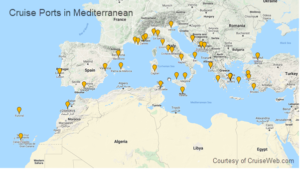 Selecting itineraries will overlap with your research, as you really need to know what itineraries are feasible as you explore them. We recently decided we wanted to go back to Australia and see those parts of Australia we had not visited on our first cruise with a goal to visit the Great Barrier Reef. This limited us to the winter time frame and we knew that we would need at least two weeks to fully enjoy the trip. This also had an impact on budget, as we were considering flying business class since this is such a long trip.
Selecting itineraries will overlap with your research, as you really need to know what itineraries are feasible as you explore them. We recently decided we wanted to go back to Australia and see those parts of Australia we had not visited on our first cruise with a goal to visit the Great Barrier Reef. This limited us to the winter time frame and we knew that we would need at least two weeks to fully enjoy the trip. This also had an impact on budget, as we were considering flying business class since this is such a long trip.
At the very least, there are several factors to consider when selecting your itinerary:
2.1 When are you traveling?
If your timing is impacted by other factors such as work schedule or school schedules, you may be limited in the itineraries from which you can choose. For example, if you must travel during the summer vacation, a trip to Australia is not a viable alternative as it will be winter there. You can save a lot of money by traveling during what is known as the shoulder season (early in the season or late in the season for your destination) or during non-peak times. We have found that traveling in late May to early June and late November early December are very economical times to travel. More flexibility will open up opportunities to travel unique itineraries (such as legs on a world cruise) and deals that are not available during peak seasons. Your cruise agent is a great asset to help you
2.2 How long can you travel?
Again, if you are limited to a single week, your options will be limited. You can extend this a bit by traveling on weekends, but keep in mind that many cruises do not leave on weekends. Likewise, air travel may be significantly higher on weekends. If you can travel for 2 to 3 weeks, a lot more options will be open to you. You should also allow an extra day at the front of the cruise for travel as I highly recommend you arrive a day before the ship sails in case something happens (e.g. weather delays, missed connections) that would cause you to miss your embarkation.
2.3 Where do you want to go?
This is the fun task. There’s so many ports and so many alternatives. At this point, simply identifies some global parameters. Are you simply wanting a Caribbean vacation to enjoy the beaches? Were you looking for something exotic like Southeast Asia? Or maybe the Galapagos Islands? If you have some specific goal in mind, such as seeing a specific port or experiencing some unique activity, make sure you consider this in selecting your destinations. Your research in the next step will help you filter and refine your itinerary.
Step Three: Research
I like to do my own research so that I know what alternatives I have available to me. Sometimes I even fine some real bargains, such as the time I found that we could book a suite for the price of a balcony on our visit to Hawaii. This also provides me with information I need so that, when I contact my agent, I can be clearer on what I want. If you do not like to do your own research, I suggest you spend a little time getting familiar with the locations you are planning to visit so that you can discuss them with your agent.
There are many good booking sites that allow you to research your cruises. They we all follow similar approach to booking and provide you basic pricing, information on the ship and cabins, and any current amenities and specials.
While your methods may vary, here is the process I follow when doing my research.
3.1 Start with a broad search.
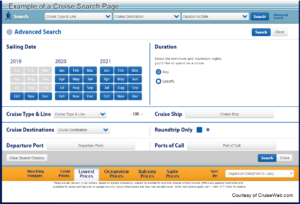 Use a robust cruise search engine to identify which lines service your general itinerary area and what ports they visit. You may find some interesting itineraries. If you are targeting a more exotic destination, you may find that one of the world cruises has a segment with an unusual itinerary. Likewise, there may be some deals that pop out (this is how we ended up with a suite on our Hawaii cruise for the price of a balcony cabin). Be flexible and just absorb what is possible. Finally, look at rates a few weeks before and after you ideal timeframe to find out if you could get better rates by adjusting your dates a little.
Use a robust cruise search engine to identify which lines service your general itinerary area and what ports they visit. You may find some interesting itineraries. If you are targeting a more exotic destination, you may find that one of the world cruises has a segment with an unusual itinerary. Likewise, there may be some deals that pop out (this is how we ended up with a suite on our Hawaii cruise for the price of a balcony cabin). Be flexible and just absorb what is possible. Finally, look at rates a few weeks before and after you ideal timeframe to find out if you could get better rates by adjusting your dates a little.
3.2 Narrow the choices.
Once you have a feel for what is available, narrow down your choices. The factors you use will be personal to you, but I generally use the cruise lines (exclude those lines I do not prefer), ports of call (if you have something specific), and any overt deals that might (and I reiterate “might”) look good. Also, price may be a factor at this time as some of the luxury lines can be very expensive. Also, look at different cabin configurations to get a sense what mix might be good for you if you need multiple cabins.
3.3 Examine specific itineraries.
Look at the itineraries with a focus on how many port (versus sea) days you will have, how long the ship is in a port (I like overnight stays), and when the ship is in port (some lines arrive late in the day and leave late at night). Understanding the itineraries is especially important if you have some specific ports you want to see. For example, we are cruising Australia next year and want to see the Great Barrier Reef. After looking at the itineraries, we discounted several since their stays at ports convenient to the Great Barrier Reef were not sufficiently long to enjoy a relaxed excursion to the reefs. Likewise, on a South American cruise, we were interested in stopping at Stanley Island to see penguins and, therefore, had to exclude any itinerary which did not incorporate this stop.
3.4 Determine what deals are available.
Most sites let you know what deals are available. I also subscribe to a lot of sites, including the cruise lines, so I get notices on deals that are available. My biggest caution is not to get fooled by the deals. Some lines offer free drink packages, but the cruise rate is increased from the rate without the drink package – in one instance we saw a $400 increase. However, you will come across some legitimate good deals. When we traveled to Hawaii, Norwegian offered a suite with free air from selected cities, prepaid gratuities, excursion credits, specialty dining, and a one night pre-cruise hotel with shuttle. When I compared the price against what a balcony cabin would have cost and added these costs, it turned out that the suite was less expensive for us – plus we got a larger room, our own dining room for breakfast and lunch, a concierge and butler, plus a lot more. Needless to say, it was a wonderful trip.
3.5 Develop shortlist of candidate cruises.
Build your short list of cruises that meet your criteria and evaluate them in more detail. Get your ducks in line before the next step.
Step Four: Contact My Agent
At this point, I contact my agent, Kevin, and outline my plans to him. Since I have booked a lot of cruises through Kevin, he knows what I like and don’t like. Several times he has nudged me away from my choices for a variety of reasons. At other times, he has been surprised by what I found. But, in all cases, he has worked with me to get the best pricing. On a few occasions, I thought I had found a good deal and Kevin pointed out that the room I had picked was an obstructed view or in a noisy location. This is why I use an agent. Kevin will price out several alternatives for me and, if I am considering one, he will place a complementary hold while I check out other factors (such as air fare) before booking. A good agent will never try to steer you to a cruise you do not want (beware of the “have I got a deal for you”) and will work with you over multiple calls to resolve all the details. They will also relay experience of their other clients regarding your ship and itinerary. I find my discussions with Kevin are always enlightening.
Step Five: Finalize Booking
After checking out any ancillary details, select a cruise and a cabin. You will have done all the background work in the previous steps. Now you need to finalize your selection and make a down payment. Don’t forget to purchase cruise insurance if you want to be covered for pre-existing conditions. Once you have completed the initial booking, the cruise line will enable an on-line account where you can manage your booking. There are a number of details that you still need to address.
5.1 Purchase air fare.
Read my post on flight planning. Depending on how far out you are booking, you may not be able to purchase air. In any event, I highly recommend you monitor air fares using an aggregator site, such as Kayak, and that you check the rates available from the cruise lines. Some cruise lines, such as Cunard, require you to call one of their representatives. If this is the case, my agent is willing to serve as an intermediary. Most lines, however, do have an online air booking engine on which you can check rates. When rates are comparable, I tend to book through the cruise lines since they provide additional services and many do not require payment until the final cruise payment.
5.2 Book pre- and post-cruise stays.
I recommend that you at least one day before your departure. Read my post on pre- and post-cruise extensions. In some cases you may want additional days to explore your departure city. You may also want some time at the end of your cruise to explore. If this is the case, book your hotels, car rental, and any special events as soon as you can. I only book hotels and car rentals that I can modify or cancel with no penalty, but that is entirely your choice. After I have booked, I check periodically to see if there are any better deals. This is especially important when booking six months or more in advance. Be careful not to wait too long, as hotels can fill up and car rentals, especially overseas, can disappear.
5.3 Complete your cruise lines booking information.
 Your cruise line’s online website will be your best friend getting ready for the cruise. Not only is it a great source of information for your cruise, but it is also the place where you will provide information regarding your party and your preferences. These websites have evolved over recent years. Not only do you fill in the blanks, but you can research your ports and sign up for everything in advance. Spend time on this site to get prepared for your trip and check it occasionally for any updates or announcements.
Your cruise line’s online website will be your best friend getting ready for the cruise. Not only is it a great source of information for your cruise, but it is also the place where you will provide information regarding your party and your preferences. These websites have evolved over recent years. Not only do you fill in the blanks, but you can research your ports and sign up for everything in advance. Spend time on this site to get prepared for your trip and check it occasionally for any updates or announcements.
I also recommend that you review the available excursions and purchase any “must do” excursions in advance. We have found out that some, especially those that require special transportation such as trains and whale watching, tend to fill quickly. If you hesitate, you may miss out. The lines vary in how you pay for advance excursions, so check out their policy.
Let the cruise line know about any special requirements or special occasions. Their goal is to make your cruise extra special.
5.4 Get any necessary visas and vaccinations.
This is an essential step that, if not completed, could keep you off the ship. Many countries require visas. Some, like China and Brazil, can take significant time to obtain. Others, such as Australia, are much simpler. Also, be aware that visa requirements for non-US citizens may be different, so don’t make any assumptions. It took us nearly 3 months to get our visa for China because they kept rejecting our photos. We did not find out we needed one for Australia until we were checking in for our flight and the agent told us about the requirement. Fortunately, they could process the visa immediately for us. Go to the Department of State website to determine whether a visa is required for your destinations.
Like visas, vaccinations may be required for your trip. If you are visiting Brazil, for example, you will be required to have proof of a yellow fever vaccination. This should not be a problem, but you must go to special clinics to get it since the serum is in short supply. Check the Centers for Disease Control site for advice on vaccinations, but also check with your cruise agent and on the cruise line site.
My best advice is to check with your travel agent and to give yourself plenty of time, especially if you are visiting an exotic location.
Step Six: Enjoy Your Cruise
As your cruise date approaches, you will have many items to handle. Check out my posts on what to do 2 weeks prior to the cruise and at the last minute. As with any vacation, a cruise vacation will be much more enjoyable if you prepare.
For me, planning the trip is a lot of fun and an opportunity to learn a lot about where we are going. Please let me know if I have forgotten anything or if you have some suggestions based on your experience in the comments below.




